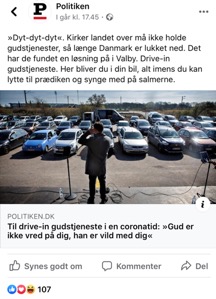-By Ole B. Jensen, Aalborg University
The auto-mobilized flexibility of ‘drive-inn’ or ‘drive-through’ services is well known all over the world. Since the booming 1950’s American car-culture has often been symbolised with representations of drive-in movie theatres, fast-food chains, banks, home depos etc. Cultural practices such as barbecue parties held on parking lots while waiting for sports events named ‘tail gaiting’ is an illustration of how the car mediates and enact various cultural practices (1). For decades McDonalds have been offering drive-in fast food services in Europe, and today it is quite commonplace to drive through a hardware store in the out-of-town shopping areas in Danish cities. In Denmark, we have also had drive-in cinemas, however, not on any large scale and most often as a more exotic American-inspired feature.
In the early days of the corona crisis in the USA, we started seeing reports about drive-inn or drive-through corona tests facilities being set-up (2). Not long hereafter Danish hospitals followed suit with drive-in test facilities (3). Drive-in church services are now the latest twist on the ‘auto-mobilization of corona’ to be reported in Danish media. Today the Danish newspaper Politiken reports about a drive-in church service held yesterday (Palm Sunday) in Valby, a suburban neighbourhood to Copenhagen (4). The newspaper report of the event on social media reads; “Honk-Honk-Honk. Churches all over the country have been closed down for services as long as Denmark is closed down. They have found a solution to this in Valby. Drive-in church service. You stay in your car while you listen to the preaching, and you can sing along on the psalms” (my translation).

As my last blog entry here titled ‘Driving through Corona City’ (4) this re-opens reflections on the discussion of the so-called ‘cocooning’ and the car. As I stated there, I am critical of the ‘iron cage’ description of the car. Rather, I see the car as filtering and mediating the ‘I-world’ relation. In thinking about ‘driving through corona city’, I did conclude that there is an element of cocooning related to the car. The recent case of Danish drive-in church services seems to support this. What was taking place in Valby, Copenhagen yesterday was in some respect a case of utilizing the ‘car as shield’ against the real and imagined corona virus threat by your neighbouring worshipper. As the wicker of the local church lamented the lack of co-present worshipping, he realized that the solution was exactly the car as it shielded off the members of the congregation sufficiently to be able to do service. From the newspaper account we learn that it was only permitted to have the left-side car window open, and that cars had to be parked with sufficient safe distance between them (2 meters). There were, however, accounts of small exceptions as for instance a woman waving her hands up though the sun-roof of the car, or the two girls watching the service with an open backdoor of the car (hatchback model that is).
How to make sense of all this in the light of critical Automobility analysis? Obviously, this is yet another case of car-based stratification and even exclusion. How can you attend drive-in church service if you do not have access to a car? Thus, this dimension inscribe itself into the long line of other forms of ‘exclusion by the car’ (as the drive-in corona test facilities also suggest). However, here I want to return to my interest in the ‘filtering vs cocooning’ discussion. At first glance, the practice of organizing a drive-in church service seems to suggest that, yes the car is a cocoon. This is precisely why the service is doable without violating the corona security enforcement-rules. However, if you start looking more closely, this service would not make sense if the car truly were a cocoon let alone an ‘iron cage’. The visual engagement with the wicker and the band mediated via a large TV screen and AV audio systems would not make sense if service could not be seen or heard. The waiving of hands out of car windows, and the honking of horns are clear elements of an interactional reciprocity and two-way communication. Something that is impossible to do if you are ‘sealed off’ and isolated from the world. The news reporter also notices that the wicker shouts out ‘can we dance a bit?’ and the car-drivers start honking the horns and rocking the cars from side to side. Creating a technologically mediated and admittedly slightly more ‘slow dance’ than you would normally see. The cars turned into movable envelopes that register body-movement even with some friction compared to the effortless dance that would have been the situation had the congregation met at its ordinary Sunday church.
This small story provoked my sociological imagination as so much else have done in these strange corona times. However, it is also testament to why it is important that a critical Automobility analysis take point of departure in the car as a filtering and mediating device, rather as a cocooning device. The case here seem exotic perhaps but it is just another piece to the puzzle of understanding how we inhabit the world through technology of the car.
References
- Ben-Joseph, E. (2012) ReThinking a lot: the design and culture of parking, Cambridge Mass.: MIT Press
- https://abcnews.go.com/US/coronavirus-testing-including-drive-clinics-covid-19-spreads/story?id=69584513
- https://www.avisen.dk/oestjysk-sygehus-laver-drive-in-test-for-tjek-af-cor_589166.aspx
- https://politiken.dk/indland/art7740989/%C2%BBDet-er-megafedt-at-det-her-er-en-mulighed%C2%AB
- https://cas.ihs.ac.at/driving-through-corona-city/